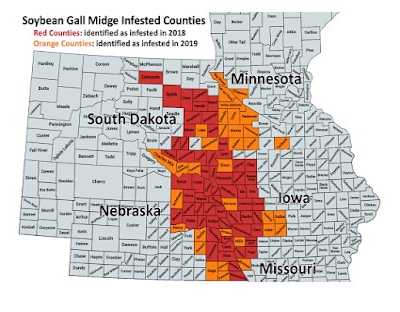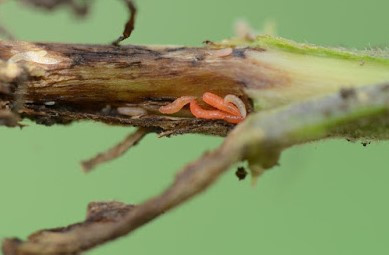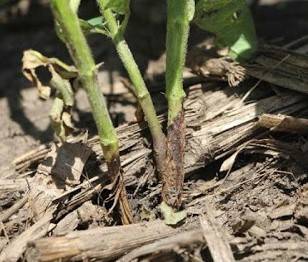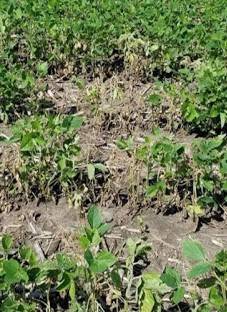By Bruce Potter and Bob Koch
The first detection of adult soybean gall emergence for 2020 was June 10 in Cass County, Nebraska. We expect that emergence will soon begin in Minnesota. Emergence of the adults of the overwintering generation will be tracked in infested states, including Minnesota (Figure 1). Updates can be found at soybeangallmidge.org.

Figure 1. Counties where the soybean gall midge has been observed.
Biology and damage
It is unlikely you will observe the tiny (2-3 mm) adults in the field. They are slender and mosquito-like in appearance with orange abdomens, mottled wings, and long legs with light and dark bands (Figure 2).

Figure 2. Adult soybean gall midges are small,slender flies. The body color, along with patterns on wings and legs are key characteristics.
The adults emerge from the previous year’s soybean fields for approximately two weeks in June. They lay eggs in naturally occurring cracks or wounds in the lower stem of soybean plants where the larvae will develop. Earlier plantings of soybean are often more heavily infested. A generation is completed in 25-30 days. The separate emergence periods of the adults from each generation is called a flight. There are an overwintering flight and at least two summer flights during the growing season.
The larvae are the damaging stage. The legless, maggot-like larvae are found beneath the surface of the soybean stem, typically at the base of the plants. Young soybean gall midge larvae are pale and become bright orange in the 3rd (final) instar (Figure 3). Mature larvae drop to the soil to pupate, with larvae of the last generation overwintering in loose cocoons in the soil.

Figure 3. Soybean gall midge larvae are small white- to orange-colored maggots.
Plant symptoms and larval infestations become visible after the V3 soybean growth stage. Larval feeding causes blackened areas at the base of the stem, with heavily infested areas of stems deformed and necrotic (Figure 4). Injury can result in stunting, wilting and death of soybean plants (Figure 5). Damaged stems can lodge or break easily. In heavily infested fields, yield reductions of up to 100% on field edges have been recorded.

Figure 4. Symptoms of soybean gall midge infestation at base of soybean stem.

Figure 5. Soybean gall midge infestation in field, showing wilting and plant death.
Identifying potential problem fields
Larvae and symptoms of their infestations in plants begin to appear a week or so after adult emergence. Look for infestations on edges of fields adjacent to fields that had soybean the previous year. Look for a dark discoloration at the base of the stem and wilting or dead plants. Stems of infested plants become brittle and can break near the soil. Peel back the outer layer of the stem and look for larvae.
Low density infestations are most easily found in August during the 3rd larval generation.
It is possible to mistake the non-pest species, the white mold gall midge, for soybean gall midge.
Management
Particularly in Minnesota, where known yield-limiting infestations have been rare, the detection of soybean gall midge adults does not necessarily mean you need to apply an insecticide.
Currently available seed-applied insecticides do not appear to provide adequate control. Extended adult emergence and multiple generations make insecticide control of adults with foliar applied insecticides difficult. Also, larvae inside the stems are protected from most foliar applied insecticides.
Research on the insecticide control of soybean gall midge is still very limited. Research from Nebraska in 2019 showed a potential yield benefit from pyrethroid insecticides applied within 10 days of adult emergence. If adult emergence has been detected in MN and that field, or an adjacent field, had a significant gall midge infestation in 2019, you might consider an insecticide.
Soybeangallmidge.org provides management tips, including a checklist for helping determine if your field might benefit from an insecticide.
Source : umn.edu